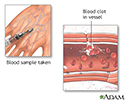Fibrinolysis - primary or secondary
Primary fibrinolysis; Secondary fibrinolysisFibrinolysis is a normal body process. It prevents blood clots that occur naturally from growing and causing problems.
Primary fibrinolysis refers to the normal breakdown of clots.
Secondary fibrinolysis is the breakdown of blood clots due to a medical disorder, medicine, or other cause. This may cause severe bleeding.
Causes
Blood clots form on a protein called fibrin. The breakdown of fibrin (fibrinolysis) can be due to:
- Bacterial infections
- Cancer
- Intense exercise
- Not enough oxygen to tissues
Your health care provider may give you medicines to help blood clots break down more quickly. This may be done if a blood clot causes a heart attack or other medical problem.
References
Brummel-Ziedins K, Mann KG, Fredenburgh JC, Weitz JI. Molecular basis of blood coagulation. In: Hoffman R, Benz EJ, Silberstein LE, et al, eds. Hematology: Basic Principles and Practice. 8th ed. Philadelphia, PA: Elsevier; 2023:chap 125.
Schafer AI. Disseminated intravascular coagulation and bleeding in liver failure. In: Goldman L, Cooney KA, eds. Goldman-Cecil Medicine. 27th ed. Philadelphia, PA: Elsevier; 2024:chap 161.
Weitz JI. Hemostasis, thrombosis, fibrinolysis, and cardiovascular disease. In: Libby P, Bonow RO, Mann DL, Tomaselli GF, Bhatt DL, Solomon SD, eds. Braunwald's Heart Disease: A Textbook of Cardiovascular Medicine. 12th ed. Philadelphia, PA: Elsevier; 2022:chap 95.
-
Blood clot formation - illustration
Blood clotting normally occurs when there is damage to a blood vessel. Platelets immediately begin to adhere to the cut edges of the vessel and release chemicals to attract even more platelets. A platelet plug is formed, and the external bleeding stops. Next, small molecules, called clotting factors, cause strands of blood-borne materials, called fibrin, to stick together and seal the inside of the wound. Eventually, the cut blood vessel heals and the blood clot dissolves after a few days.
Blood clot formation
illustration
-
Blood clots - illustration
Blood clots (fibrin clots) are the clumps that result when blood coagulates.
Blood clots
illustration
-
Blood clot formation - illustration
Blood clotting normally occurs when there is damage to a blood vessel. Platelets immediately begin to adhere to the cut edges of the vessel and release chemicals to attract even more platelets. A platelet plug is formed, and the external bleeding stops. Next, small molecules, called clotting factors, cause strands of blood-borne materials, called fibrin, to stick together and seal the inside of the wound. Eventually, the cut blood vessel heals and the blood clot dissolves after a few days.
Blood clot formation
illustration
-
Blood clots - illustration
Blood clots (fibrin clots) are the clumps that result when blood coagulates.
Blood clots
illustration
Review Date: 3/31/2024
Reviewed By: Todd Gersten, MD, Hematology/Oncology, Florida Cancer Specialists & Research Institute, Wellington, FL. Review provided by VeriMed Healthcare Network. Also reviewed by David C. Dugdale, MD, Medical Director, Brenda Conaway, Editorial Director, and the A.D.A.M. Editorial team.



